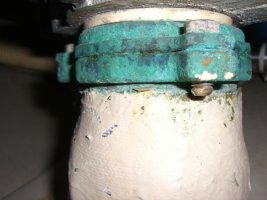Akavishon
Member III
First of all, friendly greetings to all the fellow Vikings!
I am a fresh (and very happy) owner of a beautiful '86 E32-3, hull #678. It's my 1st boat ever, so I've been working my way up the (steep!) learning curve and intensively consuming EY.org and other sites for over 2 months now ... I must say, EY.org rocks, it's jam-packed with useful information, I've learned a lot here and want to thank you all - and especially the creator/admin - for making it the most prominent Ericson information resource on the web!
That brings me to the water-in-the-bilge issue. Over the past few weeks, I've mostly tracked down the sources of my problems, so maybe I'm just looking to say hello to the forum, confirm my understanding of the E32 bilge configuration, and get some advice on how to proceed.
On my boat, there seem to be two main leak sources:
a) Rain coming down the mast. Most of it goes directly into the shower sump (just aft of the mast), but some of it occasionally leaks through the mast step onto the sole. I figured this was not worth fixing - easily dealt with by tying a towel around the mast base, and pumping out the sump occasionally (or let the auto sump pump deal with it).
b) Salt water. I'm taking on a bucket-full of salt water each time I go out for a few hours. The amount depends on the conditions - more aggressive sailing will yield more water in the bilge. Worst of all, when the boat is strongly heeled, the water spills out of the shallow bilge and soaks the sole and the cabinetry. Based on your comments, I figure this is a lot of water, and needs fixing.
In my quest for the source, I've finally arrived at the depth and knotmeter transducers mounted under the v-berth. The knotmeter is replaced with a plug, but the area appears very moist, and the wooden backing plates on both through-hulls are soaked. From what I can tell, it looks like one (or both) transducers are admitting water, which drains into the bilge compartment forward of the mast, then runs under the mast step, below the shower sump, filling the bilge compartments aft of the shower sump. This would suggest that all bilge compartments are connected by a sub-bilge, which I think I confirmed by completely drying the visible bilge compartments, then sticking a small oil pump hose into one of the limber holes and pulling out at least a quart of very smelly water.
Where to go from here? I don't suppose the transducer through-hulls can be worked on in the water? What does it take to fix them? What would more experienced Vikings recommend? Summer sailing days are very precious, so I'm a bit apprehensive to haul/fix right away, but the amount of water is disconcerting, and slowly but surely ruins my sole ...
TIA for any advice - Zoran
I am a fresh (and very happy) owner of a beautiful '86 E32-3, hull #678. It's my 1st boat ever, so I've been working my way up the (steep!) learning curve and intensively consuming EY.org and other sites for over 2 months now ... I must say, EY.org rocks, it's jam-packed with useful information, I've learned a lot here and want to thank you all - and especially the creator/admin - for making it the most prominent Ericson information resource on the web!
That brings me to the water-in-the-bilge issue. Over the past few weeks, I've mostly tracked down the sources of my problems, so maybe I'm just looking to say hello to the forum, confirm my understanding of the E32 bilge configuration, and get some advice on how to proceed.
On my boat, there seem to be two main leak sources:
a) Rain coming down the mast. Most of it goes directly into the shower sump (just aft of the mast), but some of it occasionally leaks through the mast step onto the sole. I figured this was not worth fixing - easily dealt with by tying a towel around the mast base, and pumping out the sump occasionally (or let the auto sump pump deal with it).
b) Salt water. I'm taking on a bucket-full of salt water each time I go out for a few hours. The amount depends on the conditions - more aggressive sailing will yield more water in the bilge. Worst of all, when the boat is strongly heeled, the water spills out of the shallow bilge and soaks the sole and the cabinetry. Based on your comments, I figure this is a lot of water, and needs fixing.
In my quest for the source, I've finally arrived at the depth and knotmeter transducers mounted under the v-berth. The knotmeter is replaced with a plug, but the area appears very moist, and the wooden backing plates on both through-hulls are soaked. From what I can tell, it looks like one (or both) transducers are admitting water, which drains into the bilge compartment forward of the mast, then runs under the mast step, below the shower sump, filling the bilge compartments aft of the shower sump. This would suggest that all bilge compartments are connected by a sub-bilge, which I think I confirmed by completely drying the visible bilge compartments, then sticking a small oil pump hose into one of the limber holes and pulling out at least a quart of very smelly water.
Where to go from here? I don't suppose the transducer through-hulls can be worked on in the water? What does it take to fix them? What would more experienced Vikings recommend? Summer sailing days are very precious, so I'm a bit apprehensive to haul/fix right away, but the amount of water is disconcerting, and slowly but surely ruins my sole ...
TIA for any advice - Zoran

